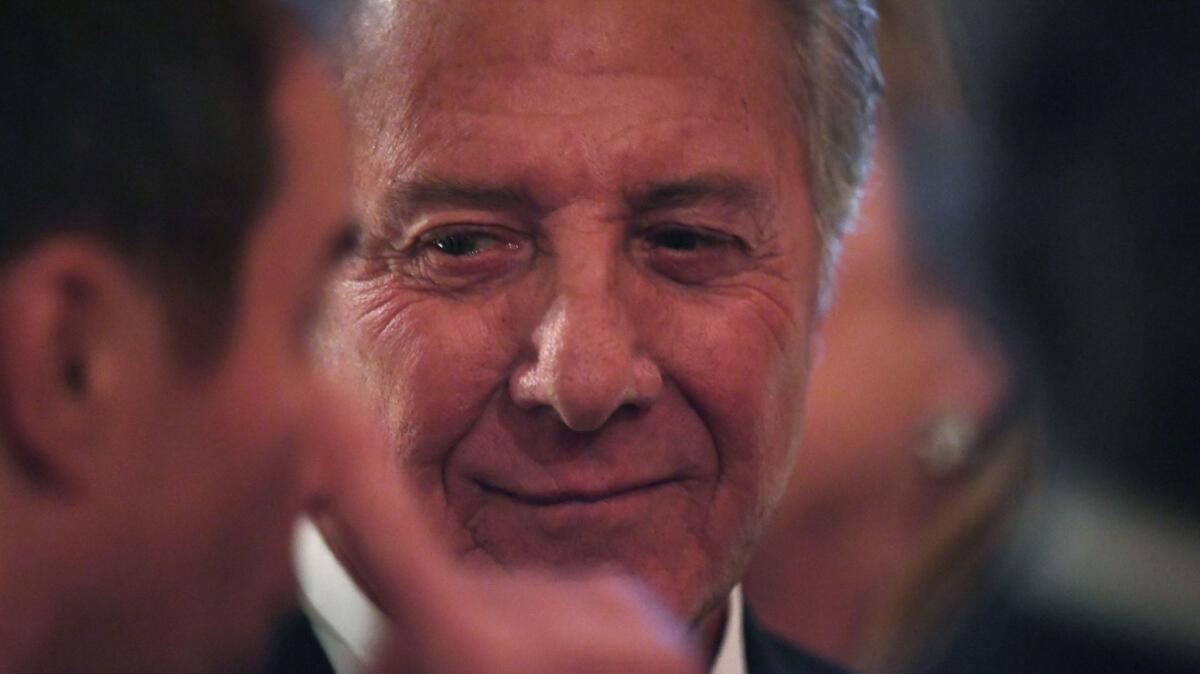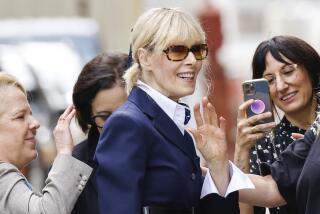Op-Ed: I publicly accused Dustin Hoffman of harassment. Take it from me, it’s not easy to expose sexual misconduct

- Share via
A friend called me recently, anxious. Like many men, he was scared he might get caught in the net of sexual harassment accusations. “Anyone with a grudge could make up a story about me and get me fired,” he said. “Is that OK with you, if innocent men lose their jobs and careers?”
I took a breath, hoping to offer a measured response. Instead, I snapped: “If you had any idea how hard it is to get these stories published, you wouldn’t be worried about your career.”
Since early November, when I published a personal essay alleging that Dustin Hoffman sexually harassed me, I’d been trying to organize a reported follow-up article that would bring together multiple accusers.
The same day my friend called, one potential source got cold feet. She thought others would blame her for what happened, even if she spoke off the record. The night before, as I was sitting down to dinner, another source I’d been trying to reach for days finally responded. I spent the next hour on the phone with her, my stomach growling as the burger in front of me grew cold.
Judging from an avalanche of think pieces, my friend’s concerns are common — many believe the pendulum is swinging too far in the accusers’ direction, or that the #MeToo movement is becoming a witch hunt. But the process of bringing sexual harassment stories to light is still a tedious mess.
Here’s how I published my original Hoffman article:
After the news about Harvey Weinstein broke, I emailed seven journalists about Hoffman, imagining that at least one of them would have heard from other accusers. Only one called me back, and she had heard nothing. It was obvious that if I wanted her to write a story, I would have to find the backup sources myself.
There’s no clearinghouse for accusations. Given that the Equal Employment Opportunity Commission estimates that 75% of all incidents of workplace harassment go unreported, and that Hoffman has made 60 movies, amounting to 60 different workplaces, I was overwhelmed by the possibilities.
While many [of his accusers] wanted Hoffman outed, most decided not to speak to the reporter at all, much less on the record.
I decided to write an essay focused only on my personal experience, which I pitched to six outlets. I heard back from none. Eventually, Janice Min, whom I’d contacted on Twitter, connected me with the editor of the Hollywood Reporter. Even with documentation and a witness corroborating the details, it took almost two weeks of fact-checking and legal review before THR published the story.
Many assured me that my article would have a snowball effect and inspire others to come forward. One did: Wendy Riss Gatsiounis. After her, however, the conversation died, at least publicly.
Privately, it was thriving. Women found me through Twitter, Facebook and mutual friends to share their Hoffman stories. A reporter I knew wanted to write a follow-up article, but few women came to him. I had become the clearinghouse.
While many wanted Hoffman outed, most decided not to speak to the reporter at all, much less on the record. One woman didn’t want to be part of the article because what happened to her wasn’t “Weinstein-type behavior.” One couldn’t face telling her family what she went through. One considered speaking on the record but decided not to because of a screenplay and a book deal. One wanted to talk but was steadfast about remaining anonymous because she didn’t want colleagues to know the gruesome details. Meanwhile, the reporter made clear that he needed multiple solid sources to satisfy his editors.
As the go-between, I kept a list in my head. Will she talk to the reporter? Yes/no/maybe. Will she go on the record? Yes/no/maybe. With a sickening sense of irony, I began to feel like Hoffman’s character in “All the President’s Men” as he tries to get enough witnesses to verify what he’s certain is true. It seemed intolerable that the stories I’d heard might stay in the dark.
Two women agreed to go on the record in order to provide cover for two others who wanted to remain anonymous. But even with four sources, it seemed as though the article could fall apart at any moment. First, the reporter had to work on another story. Then, he missed a call with one of the women, and she almost dropped out. She said, “I was up all night anxious — left work early to be in a safe place to talk and no call. It may not be a big deal for him to cover this story, but it is for me.”
When the reporter cut one woman’s story, another pulled out in solidarity. On a conference call the next day, three of the women decided to work with a new reporter. The fourth — the one with the most humiliating experience of all — told us she no longer could be a part of the process, even off the record. She had been trying to get her story told for more than two months. She said that sharing the details of one of the most painful nights of her life with yet another stranger would be like “giving another piece of myself away.”
On Thursday, the article finally came out in Variety. It did not include the fourth woman’s account.
With so many new tales of sexual harassment, it’s easy to assume — depending on your perspective — that either no rock will be left unturned or that no man is safe from accusation. But what the public perceives as an onslaught is just a fraction of what’s going on.
For a few reasons, we will never know all the stories of ugliness at the hands of well-known men.
- Most victims don’t want to talk about their humiliating experiences, even off the record. Building a story requires trust, and that trust is precarious.
- Publications have high standards for reporting allegations. If there are more stories of sexual harassment now than ever before, it is because of a shift in focus and not a drop in standards.
- Even with that shift in focus, news outlets are still pulled in multiple directions. A famous person accused of harassment, enough sources and a willing reporter are not always enough; sometimes a story needs someone pushing to make it happen.
The Variety article on Dustin Hoffman featured only three women, but those three stand for many others.
Anna Graham Hunter is a writer who lives in Los Angeles. Follow @annaghunter
Follow the Opinion section on Twitter @latimesopinion or Facebook
More to Read
A cure for the common opinion
Get thought-provoking perspectives with our weekly newsletter.
You may occasionally receive promotional content from the Los Angeles Times.










